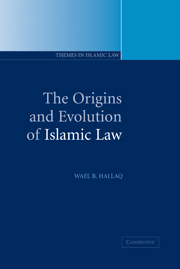Book contents
- Frontmatter
- Contents
- Maps
- Map 1 Arabia ca. 622 ad
- Map 2 Muslims lands in the third/ninth century
- Introduction
- 1 The pre-Islamic Near East, Muḥammad and Quranic law
- 2 The emergence of an Islamic legal ethic
- 3 The early judges, legal specialists and the search for religious authority
- 4 The judiciary coming of age
- 5 Prophetic authority and the modification of legal reasoning
- 6 Legal theory expounded
- 7 The formation of legal schools
- 8 Law and politics: caliphs, judges and jurists
- Conclusion
- Glossary of key terms
- Short biographies
- Bibliography
- Suggested further reading
- Index
7 - The formation of legal schools
Published online by Cambridge University Press: 05 June 2012
- Frontmatter
- Contents
- Maps
- Map 1 Arabia ca. 622 ad
- Map 2 Muslims lands in the third/ninth century
- Introduction
- 1 The pre-Islamic Near East, Muḥammad and Quranic law
- 2 The emergence of an Islamic legal ethic
- 3 The early judges, legal specialists and the search for religious authority
- 4 The judiciary coming of age
- 5 Prophetic authority and the modification of legal reasoning
- 6 Legal theory expounded
- 7 The formation of legal schools
- 8 Law and politics: caliphs, judges and jurists
- Conclusion
- Glossary of key terms
- Short biographies
- Bibliography
- Suggested further reading
- Index
Summary
With the emergence of legal theory by the middle of the fourth/tenth century or thereabouts, Islamic law can be said to have become complete, save for one essential and fundamental feature which we have not yet discussed. This is the phenomenon of the legal schools, one of the most defining characteristics of Islamic law. In order to understand this complex phenomenon, it is perhaps best to begin with a survey of the meanings that are associated with the Arabic term “madhhab,” customarily translated into the English language as “school.”
THE MEANINGS OF MADHHAB
Derived from the Arabic verb dhahabal yadhhabu (lit. “went/to go”), the verbal noun madhhab generally means that which is followed and, more specifically, the opinion or idea that one chooses to adopt. It is almost never applied by a jurist to his own opinion, but rather used in the third person, e.g., the madhhab of so-and-so is such-and-such. The most basic meaning of the term is thus a particular opinion of a jurist. Historically, it is of early provenance, probably dating back to the end of the first/seventh century, but certainly to the middle of the second/eighth. By the early third/ninth century, its use had become frequent.
The madhhabs and their history, however, are not associated with this basic usage to any meaningful extent, for it is conceivable that the usage might have persisted without there being any schools at all. In fact, it was already in circulation before any developed notion of “school” had come to exist.
- Type
- Chapter
- Information
- The Origins and Evolution of Islamic Law , pp. 150 - 177Publisher: Cambridge University PressPrint publication year: 2004



